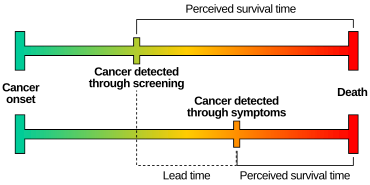
Lead time bias happens when survival time appears longer because diagnosis was done earlier (for instance, by screening), irrespective of whether the patient lived longer. Lead time is the duration of time between the detection of a disease (by screening or based on new experimental criteria) and its usual clinical presentation and diagnosis (based on traditional criteria).[1] For example, it is the time between early detection by screening and the time when diagnosis would have been made clinically (without screening).[1] It is an important factor when evaluating the effectiveness of a specific test.[2]
- ^ a b Rollison, Dana E.; Sabel, Michael S. (2007-01-01), Sabel, Michael S.; Sondak, Vernon K.; Sussman, Jeffrey J. (eds.), "3 - Basic Epidemiologic Methods for Cancer Investigations", Essentials of Surgical Oncology, Surgical Foundations, Philadelphia: Mosby, pp. 21–38, ISBN 978-0-8151-4385-7, retrieved 2021-01-14
- ^ "GPnotebook". gpnotebook.com.
© MMXXIII Rich X Search. We shall prevail. All rights reserved. Rich X Search
